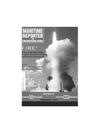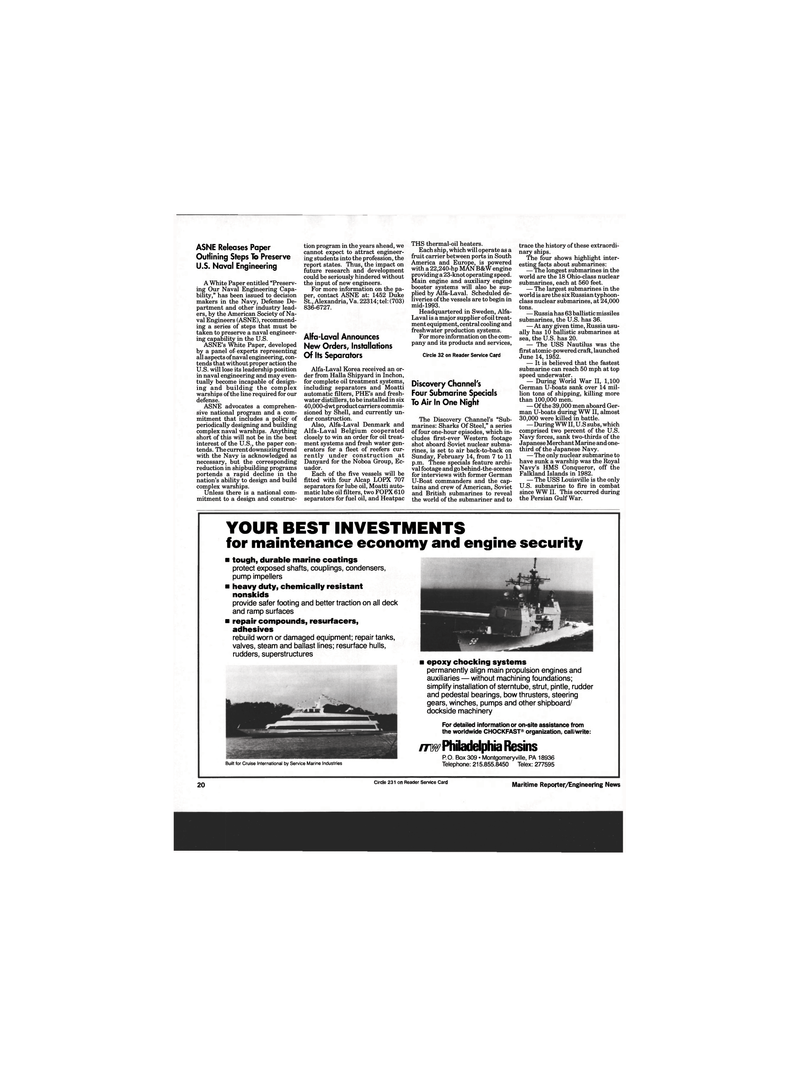
Page 18: of Maritime Reporter Magazine (February 1993)
Read this page in Pdf, Flash or Html5 edition of February 1993 Maritime Reporter Magazine
ASNE Releases Paper
Outlining Steps To Preserve
U.S. Naval Engineering
A White Paper entitled "Preserv- ing Our Naval Engineering Capa- bility," has been issued to decision makers in the Navy, Defense De- partment and other industry lead- ers, by the American Society of Na- val Engineers (ASNE), recommend- ing a series of steps that must be taken to preserve a naval engineer- ing capability in the U.S.
ASNE's White Paper, developed by a panel of experts representing all aspects of naval engineering, con- tends that without proper action the
U.S. will lose its leadership position in naval engineering and may even- tually become incapable of design- ing and building the complex warships of the line required for our defense.
ASNE advocates a comprehen- sive national program and a com- mitment that includes a policy of periodically designing and building complex naval warships. Anything short of this will not be in the best interest of the U.S., the paper con- tends. The current downsizing trend with the Navy is acknowledged as necessary, but the corresponding reduction in shipbuilding programs portends a rapid decline in the nation's ability to design and build complex warships.
Unless there is a national com- mitment to a design and construc- tion program in the years ahead, we cannot expect to attract engineer- ing students into the profession, the report states. Thus, the impact on future research and development could be seriously hindered without the input of new engineers.
For more information on the pa- per, contact ASNE at: 1452 Duke
St., Alexandria, Va. 22314; tel: (703) 836-6727.
Alfa-Laval Announces
New Orders, Installations
Of Its Separators
Alfa-Laval Korea received an or- der from Halla Shipyard in Inchon, for complete oil treatment systems, including separators and Moatti automatic filters, PHE's and fresh- water distillers, to be installed in six 40,000-dwt product carriers commis- sioned by Shell, and currently un- der construction.
Also, Alfa-Laval Denmark and
Alfa-Laval Belgium cooperated closely to win an order for oil treat- ment systems and fresh water gen- erators for a fleet of reefers cur- rently under construction at
Danyard for the Noboa Group, Ec- uador.
Each of the five vessels will be fitted with four Alcap LOPX 707 separators for lube oil, Moatti auto- matic lube oil filters, two FOPX 610 separators for fuel oil, and Heatpac
THS thermal-oil heaters.
Each ship, which will operate as a fruit carrier between ports in South
America and Europe, is powered with a 22,240-hp MAN B&W engine providing a 23-knot operating speed.
Main engine and auxiliary engine booster systems will also be sup- plied by Alfa-Laval. Scheduled de- liveries of the vessels are to begin in mid-1993.
Headquartered in Sweden, Alfa-
Laval is a major supplier of oil treat- ment equipment, central cooling and freshwater production systems.
For more information on the com- pany and its products and services,
Circle 32 on Reader Service Card
Discovery Channel's
Four Submarine Specials
To Air In One Night
The Discovery Channel's "Sub- marines: Sharks Of Steel," a series of four one-hour episodes, which in- cludes first-ever Western footage shot aboard Soviet nuclear subma- rines, is set to air back-to-back on
Sunday, February 14, from 7 to 11 p.m. These specials feature archi- val footage and go behind-the-scenes for interviews with former German
U-Boat commanders and the cap- tains and crew of American, Soviet and British submarines to reveal the world of the submariner and to trace the history of these extraordi- nary ships.
The four shows highlight inter- esting facts about submarines: — The longest submarines in the world are the 18 Ohio-class nuclear submarines, each at 560 feet. — The largest submarines in the world is are the six Russian typhoon- class nuclear submarines, at 24,000 tons. —Russia has 63 ballistic missiles submarines, the U.S. has 36. — At any given time, Russia usu- ally has 10 ballistic submarines at sea, the U.S. has 20. — The USS Nautilus was the first atomic-powered craft, launched
June 14, 1952. — It is believed that the fastest submarine can reach 50 mph at top speed underwater. — During World War II, 1,100
German U-boats sank over 14 mil- lion tons of shipping, killing more than 100,000 men. — Of the 39,000 men aboard Ger- man U-boats during WW II, almost 30,000 were killed in battle. —During WW II, U.S subs, which comprised two percent of the U.S.
Navy forces, sank two-thirds of the
Japanese Merchant Marine and one- third of the Japanese Navy. — The only nuclear submarine to have sunk a warship was the Royal
Navy's HMS Conqueror, off the
Falkland Islands in 1982. — The USS Louisville is the only
U.S. submarine to fire in combat since WW II. This occurred during the Persian Gulf War.
YOUR BEST INVESTMENTS for maintenance economy and engine security • tough, durable marine coatings protect exposed shafts, couplings, condensers, pump impellers • heavy duty, chemically resistant nonskids provide safer footing and better traction on all deck and ramp surfaces • repair compounds, resurfacers, adhesives rebuild worn or damaged equipment; repair tanks, valves, steam and ballast lines; resurface hulls, rudders, superstructures
Built for Cruise International by Service Marine Industries • epoxy chocking systems permanently align main propulsion engines and auxiliaries — without machining foundations; simplify installation of sterntube, strut, pintle, rudder and pedestal bearings, bow thrusters, steering gears, winches, pumps and other shipboard/ dockside machinery
For detailed information or on-site assistance from the worldwide CHOCKFAST® organization, call/write: nw Philadelphia Resins
P.O. Box 309 • Montgomeryville, PA 18936
Telephone: 215.855.8450 Telex: 277595 20 Circle 231 on Reader Service Card Maritime Reporter/Engineering News

 17
17

 19
19
